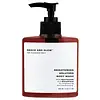What's inside
What's inside
 Key Ingredients
Key Ingredients

 Benefits
Benefits

 Concerns
Concerns

 Ingredients Side-by-side
Ingredients Side-by-side

Water
Skin ConditioningSodium Laureth Sulfate
CleansingCocamidopropyl Betaine
CleansingSodium Chloride
MaskingMethylchloroisothiazolinone
PreservativeMethylisothiazolinone
PreservativeMagnesium Chloride
Magnesium Nitrate
Sodium Lauryl Sulfate
CleansingSodium Sulfate
C12-16 Alcohols
EmollientPalm Kernelamide DEA
EmulsifyingGlycerin
HumectantParfum
MaskingSodium Lauroyl Sarcosinate
CleansingSodium Hydroxypropylsulfonate Laurylglucoside Crosspolymer
CleansingSucrose
HumectantSucrose Distearate
EmollientHexylene Glycol
EmulsifyingHydroxyacetophenone
AntioxidantLactic Acid
BufferingDMDM Hydantoin
PreservativeDisodium EDTA
CI 16255
Cosmetic ColorantCI 42090
Cosmetic ColorantCitric Acid
BufferingNiacinamide
SmoothingHydroxyapatite
AbrasiveGlutathione
Cysteine
AntioxidantEthoxydiglycol
HumectantZeolite
AbsorbentWater, Sodium Laureth Sulfate, Cocamidopropyl Betaine, Sodium Chloride, Methylchloroisothiazolinone, Methylisothiazolinone, Magnesium Chloride, Magnesium Nitrate, Sodium Lauryl Sulfate, Sodium Sulfate, C12-16 Alcohols, Palm Kernelamide DEA, Glycerin, Parfum, Sodium Lauroyl Sarcosinate, Sodium Hydroxypropylsulfonate Laurylglucoside Crosspolymer, Sucrose, Sucrose Distearate, Hexylene Glycol, Hydroxyacetophenone, Lactic Acid, DMDM Hydantoin, Disodium EDTA, CI 16255, CI 42090, Citric Acid, Niacinamide, Hydroxyapatite, Glutathione, Cysteine, Ethoxydiglycol, Zeolite
Water
Skin ConditioningCocamidopropyl Betaine
CleansingPEG-80 Sorbitan Laurate
Decyl Glucoside
CleansingAcrylates/C10-30 Alkyl Acrylate Crosspolymer
Emulsion StabilisingPhenoxyethanol
PreservativeSodium Methyl Cocoyl Taurate
CleansingParfum
MaskingSodium Benzoate
MaskingPEG-150 Pentaerythrityl Tetrastearate
EmulsifyingPPG-2 Hydroxyethyl Cocamide
EmulsifyingGlycol Distearate
EmollientCoco-Glucoside
CleansingSodium Hydroxide
BufferingEthylhexylglycerin
Skin ConditioningGlyceryl Oleate
EmollientGlyceryl Stearate
EmollientPanthenol
Skin ConditioningSodium Ascorbyl Phosphate
AntioxidantTocopheryl Acetate
AntioxidantHydrolyzed Rice Bran Protein
Skin ConditioningMilk Protein
Skin ConditioningZinc Gluconate
Skin ConditioningMagnesium Aspartate
Skin ConditioningCopper Gluconate
Skin ConditioningWater, Cocamidopropyl Betaine, PEG-80 Sorbitan Laurate, Decyl Glucoside, Acrylates/C10-30 Alkyl Acrylate Crosspolymer, Phenoxyethanol, Sodium Methyl Cocoyl Taurate, Parfum, Sodium Benzoate, PEG-150 Pentaerythrityl Tetrastearate, PPG-2 Hydroxyethyl Cocamide, Glycol Distearate, Coco-Glucoside, Sodium Hydroxide, Ethylhexylglycerin, Glyceryl Oleate, Glyceryl Stearate, Panthenol, Sodium Ascorbyl Phosphate, Tocopheryl Acetate, Hydrolyzed Rice Bran Protein, Milk Protein, Zinc Gluconate, Magnesium Aspartate, Copper Gluconate
Ingredients Explained
These ingredients are found in both products.
Ingredients higher up in an ingredient list are typically present in a larger amount.
Cocamidopropyl Betaine is a fatty acid created by mixing similar compounds in coconut oil and dimethylaminopropylamine, a compound with two amino groups.
This ingredient is a surfactant and cleanser. It helps gather the dirt, pollutants, and other impurities in your skin to be washed away. It also helps thicken a product and make the texture more creamy.
Being created from coconut oil means Cocamidopropyl Betaine is hydrating for the skin.
While Cocamidopropyl Betaine was believed to be an allergen, a study from 2012 disproved this. It found two compounds in unpure Cocamidopropyl Betaine to be the irritants: aminoamide and 3-dimethylaminopropylamine. High-grade and pure Cocamidopropyl Betaine did not induce allergic reactions during this study.
Learn more about Cocamidopropyl BetaineParfum is a catch-all term for an ingredient or more that is used to give a scent to products.
Also called "fragrance", this ingredient can be a blend of hundreds of chemicals or plant oils. This means every product with "fragrance" or "parfum" in the ingredients list is a different mixture.
For instance, Habanolide is a proprietary trade name for a specific aroma chemical. When used as a fragrance ingredient in cosmetics, most aroma chemicals fall under the broad labeling category of “FRAGRANCE” or “PARFUM” according to EU and US regulations.
The term 'parfum' or 'fragrance' is not regulated in many countries. In many cases, it is up to the brand to define this term.
For instance, many brands choose to label themselves as "fragrance-free" because they are not using synthetic fragrances. However, their products may still contain ingredients such as essential oils that are considered a fragrance by INCI standards.
One example is Calendula flower extract. Calendula is an essential oil that still imparts a scent or 'fragrance'.
Depending on the blend, the ingredients in the mixture can cause allergies and sensitivities on the skin. Some ingredients that are known EU allergens include linalool and citronellol.
Parfum can also be used to mask or cover an unpleasant scent.
The bottom line is: not all fragrances/parfum/ingredients are created equally. If you are worried about fragrances, we recommend taking a closer look at an ingredient. And of course, we always recommend speaking with a professional.
Learn more about ParfumWater. It's the most common cosmetic ingredient of all. You'll usually see it at the top of ingredient lists, meaning that it makes up the largest part of the product.
So why is it so popular? Water most often acts as a solvent - this means that it helps dissolve other ingredients into the formulation.
You'll also recognize water as that liquid we all need to stay alive. If you see this, drink a glass of water. Stay hydrated!
Learn more about Water